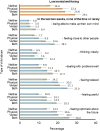Comparative relationships between physical and verbal abuse of children, life course mental well-being and trends in exposure: a multi-study secondary analysis of cross-sectional surveys in England and Wales
- PMID: 40764071
- PMCID: PMC12336579
- DOI: 10.1136/bmjopen-2024-098412
Comparative relationships between physical and verbal abuse of children, life course mental well-being and trends in exposure: a multi-study secondary analysis of cross-sectional surveys in England and Wales
Abstract
Objectives: To test associations between mental well-being across the life course and exposure to childhood physical and/or verbal abuse.
Design: Secondary analysis of combined data from seven cross-sectional general adult population surveys measuring childhood experience of physical and/or verbal abuse and current mental well-being.
Setting: Households across England and Wales.
Participants: 20 687 residents in England and Wales aged 18 years or over.
Measures: Self-reported childhood physical and verbal abuse using questions from an Adverse Childhood Experiences tool. Individual and combined components of adult mental well-being measured using the short Warwick-Edinburgh Mental Wellbeing Scale (SWEMWBS).
Results: Exposure to either childhood physical abuse or verbal abuse was associated independently with a similar significant increase in likelihood of low adult mental well-being, with exposure to both abuse types compounding increases (adjusted ORs 1.52, 1.64, 2.15 respectively, reference category: neither abuse type). Individual components of mental well-being showed similar associations, with adjusted prevalence of never or rarely having felt close to people in the last 2 weeks rising from 7.7% (neither abuse type) to 9.9% (physical abuse), 13.6% (verbal abuse) and 18.2% (both types of abuse). Within sample trends showed a significant drop in the prevalence of child physical abuse from around 20% in those born from 1950 to 1979 to 10% in those born in 2000 or after. However, verbal abuse rose from 11.9% in those born before 1950 to nearly 20% in those born in 2000 or after.
Conclusion: Exposure to childhood physical or verbal abuse have similar associations with lower mental well-being during adulthood. Interventions to reduce child abuse, including physical chastisement, should consider both physical and verbal abuse and their individual and combined consequences to life course health. The potential role of childhood verbal abuse in escalating levels of poor mental health among younger age groups needs greater consideration.
Keywords: Child; MENTAL HEALTH; Non-accidental injury; PUBLIC HEALTH; Quality of Life.
© Author(s) (or their employer(s)) 2025. Re-use permitted under CC BY-NC. No commercial re-use. See rights and permissions. Published by BMJ Group.
Conflict of interest statement
Competing interests: None declared.
Figures


Similar articles
-
Sexual Harassment and Prevention Training.2024 Mar 29. In: StatPearls [Internet]. Treasure Island (FL): StatPearls Publishing; 2025 Jan–. 2024 Mar 29. In: StatPearls [Internet]. Treasure Island (FL): StatPearls Publishing; 2025 Jan–. PMID: 36508513 Free Books & Documents.
-
Advocacy interventions to reduce or eliminate violence and promote the physical and psychosocial well-being of women who experience intimate partner abuse.Cochrane Database Syst Rev. 2015 Dec 3;2015(12):CD005043. doi: 10.1002/14651858.CD005043.pub3. Cochrane Database Syst Rev. 2015. PMID: 26632986 Free PMC article.
-
Associations between childhood trauma and adolescent psychiatric disorders in Brazil: a longitudinal, population-based birth cohort study.Lancet Glob Health. 2025 Feb;13(2):e309-e318. doi: 10.1016/S2214-109X(24)00452-2. Lancet Glob Health. 2025. PMID: 39890231
-
Pharmacological interventions for those who have sexually offended or are at risk of offending.Cochrane Database Syst Rev. 2015 Feb 18;2015(2):CD007989. doi: 10.1002/14651858.CD007989.pub2. Cochrane Database Syst Rev. 2015. PMID: 25692326 Free PMC article.
-
Investigation and analysis of mental health status of the older adult in western rural areas.Front Public Health. 2025 Jul 16;13:1612600. doi: 10.3389/fpubh.2025.1612600. eCollection 2025. Front Public Health. 2025. PMID: 40740371 Free PMC article.
References
-
- Whitten T, Tzoumakis S, Green MJ, et al. Global Prevalence of Childhood Exposure to Physical Violence within Domestic and Family Relationships in the General Population: A Systematic Review and Proportional Meta-Analysis. Trauma Violence Abuse. 2024;25:1411–30. doi: 10.1177/15248380231179133. - DOI - PMC - PubMed
Publication types
MeSH terms
LinkOut - more resources
Full Text Sources
Medical
